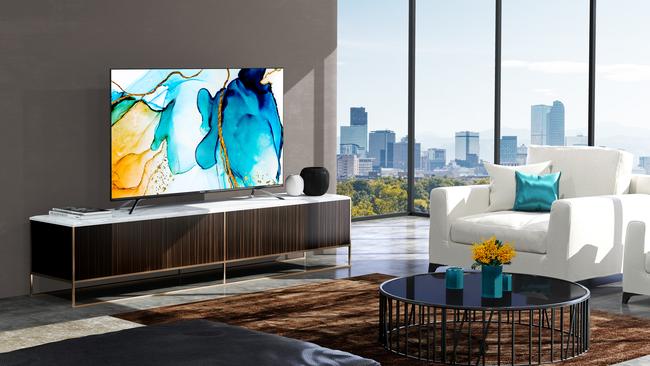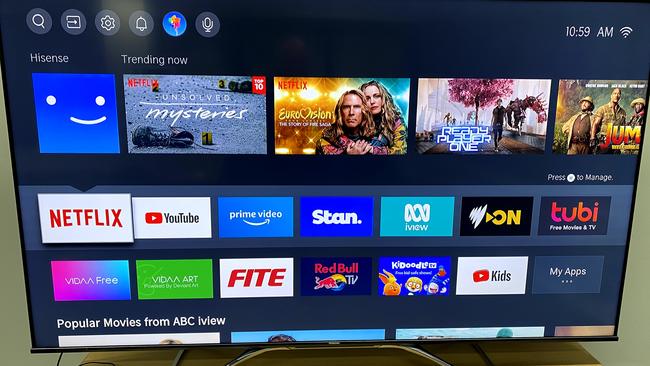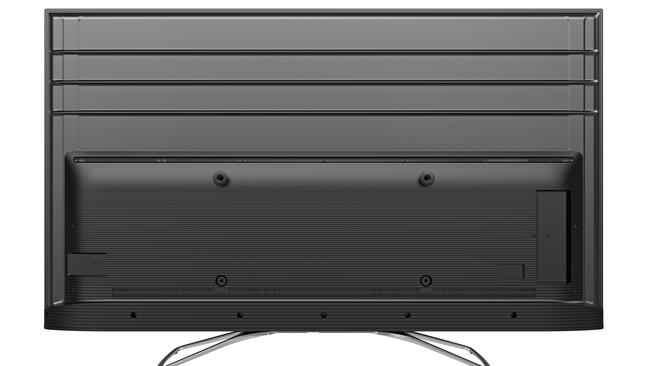Hisense takes on LG, Samsung with Q8 ULED 4K
Hisense is straddling between providing value for money while increasing viewing quality. Does it succeed?

Hisense has released its latest premium ULED TVs in Australia and I’ve been grappling with its 75-inch quantum dot model.
Soaking up the technicalities of modern-day smart TVs is a complex task for consumers. LG’s premium sets have OLED or organic LED screens, Samsung calls its display QLED for quantum dot LED while Hisense offers ULED.
OLED, QLED and ULED for many of us are three acronyms too many. So in this review, it’s worth reiterating Hisense’s ULED TV technology.
First there’s full array dimming. Instead of a single light source on a LED panel, there are more than 100 light sources each lighting up a small area of the screen. If you have a bright area of a scene next to a dark area, you shouldn’t see bleeding of light onto the dark areas.
There’s quantum dot technology, which means better colour accuracy with a bigger colour palette. Nanocrystals produce more accurate red, green, and blue light which provide millions of colours.
There’s Dolby Vision, which provides better detail in very bright and very dark parts of the display. There’s also Dolby Atmos surround sound technology.
Frames of 4K content look very sharp and detailed with exquisite colour and contrast.
The Q8 ULED 4K set has a thin bezel or frame around its edges and sits on an unobtrusive metal stand beneath it. If you wish, you can ditch the stand and use small legs available near each bottom edge.
You get the standard ports on the back of the set – four HDMI ports along with 2 USB2 ports and AV in. There’s digital audio out and a LAN port for an Ethernet cable connection.
The four HDMI ports support CEC (consumer electronics control), so the TV and devices attached to it can control each other. You might configure your remote to control an attached Blu-ray player, or conversely for the TV to automatically swap inputs to a chosen HDMI channel when you directly switch on a games console.

One port – HDMI1 – supports ARC or audio return channel. It allows for two directional flow of data. Not only can you run a cable from an ARC-enabled HDMI port from the TV to a soundbar and divert the TVs sound to the soundbar without using a separate audio cable.
You can also use the soundbar as an HDMI hub and connect other devices to it and have their input run up the cable in the other direction to the TV. That’s especially fantastic if your TV is wall mounted and you don’t have easy access to the HDMI ports on the back.
One of the most important features with smart TVs is the user interface, and this year’s sets come with Hisense’s Vidaa 4 operating system, a step up from Vidaa 3 last year.
Hisense has been slow to offer Australian apps and content on its sets, but last year you did get SBS On Demand, Stan, Netflix, and Amazon Prime among available apps.
This year it added ABC iView although you still don’t get dedicated apps for catch-up content available from Seven, Nine and Ten. You can access that catch-up content using Freeview Plus which includes a seven day EPG guide as part of the system.
Last year, you’d click on the Netflix app and see recommended content in the menu line above it. That facility has been extended to Stan and Prime. If you previously watched a streaming program on those services, you can click an item on the main menu and continue from where you left off without going through the tedium of opening the app.
The availability of common apps has been an issue for Hisense and while it does have an array of them, it misses some of the apps I use (such as Plex).
However there is a cosmopolitan selection. You get YuppTV, Classic Movies, Pocket Films and Mubi, and in music Deezer, Baeble Music, Vietnamese music app NhacCuaTui, Radioline, French radio network NRJ and Voyage Music.

The menu interface is straightforward with a row of popular content selections followed underneath by two rows of favourite apps and then groups of rows for media providers such as Netflix, YouTube, Stan iView, Prime Video, SBS On Demand, and Tubi. In many cases, you get content previews.
You can use the supplied conventionally set-out remote or Hisense’s RemoteNow app available for smartphones.
Hisense TVs now come with Amazon Alexa built in, but to use Google Home, the TV needs to access a Google Home device on your home network. TV voice command options have improved since last year; you can now ask the TV to open apps and search for content on YouTube and Tubi, in addition to selecting the input source, but this isn’t as advanced as voice command systems offered by some competitors.
Hisense says it is working to extend the voice search and universal search capability but you’ll need to wait for a future firmware update for this.
Rivals Samsung and LG have sets in the market that display art pieces. Hisense this year has added its own offering – “Vidaa Art” which it says gives owners access to millions of digital art pieces worldwide that you can display when the TV isn’t in use.
These are not standard gallery images but rather a collaboration with community art source DeviantArt. Hisense says DeviantArt has more than 48 million members who have submitted more than 370 million art pieces. So you shouldn’t be lacking choice when you create art playlists. You can also use suggested playlists and display your own family photos.
The Hisense Q8 ULED 4K TV is very good value for money, given its picture quality and all around capability with Dolby Vision and Dolby Atmos. Its choice of apps may not appeal to some and the use of voice assistant commands is not as advanced as with Samsung and LG.
Recommended costs for the 55, 65, 75 and 85-inch models are $1799, $2499, $3699 and $5499.


